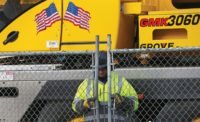In the wake of a further Federal Transit Administration safety directive—and a shutdown warning from U.S. Transportation Secretary Anthony Foxx—the Washington, D.C., area's Metrorail system is moving to fix electric-power problems believed to have caused a series of smoke and fire incidents over the past several weeks.
FTA sent a notice on May 11 to the Washington Metropolitan Area Transit Agency (WMATA)—Metrorail's operator—directing it to make urgent repairs at three sections of the system before the scheduled June 4 start of a newly announced, year-long SafeTrack program. SafeTrack aims to accelerate extensive maintenance work at 15 locations on the 117-mile network.
Work at two locations—one of which WMATA listed in its SafeTrack schedule—includes cleaning drains;removing mud and debris from tracks and safety walks; sealing cracks and cleaning tunnel liners; inspecting and repairing drainage pumps; inspecting power traction cables and welds; replacing insulators and third-rail coverboards; eliminating third-rail expansion joints; repairing fasteners and bolts in the direct fixation system; and replacing corroded rail and defective tie plates.
At the third location, originally scheduled to undergo intense repair work in March 2017 under SafeTrack, WMATA is to focus on the traction power electrification system, including replacement of third rail components, as well inspecting the drainage system for prioritizing repairs.
FTA also called on WMATA to provide inspection and maintenance procedures for tunnel drainage and traction power cabling system to determine the sustainability of current and future repairs. WMATA must also re-establish a program for cleaning insulators and removing debris within 30 days.
WMATA spokesperson Dan Stessel said in a statement that Metro would revise its SafeTrack schedule to accommodate FTA’s directive. He added that it will complete removing porcelain insulators from its underground stations within a month. National Transportation Safety Board-recommended sealing sleeves also will be installed on all underground power cables by the end of May.
In response to a May 7 FTA directive regarding power draw—believed to be a contributing factor in several smoke and fire incidents—WMATA General Manager Paul Wiedefeld has imposed speed and acceleration restrictions on trains operating in the system’s underground downtown core areas, Stessel said.
Foxx told reporters on May 10 that after a fire five days earlier at a downtown station—the latest of eight smoke and fire incidents within two weeks—he “seriously thought about” calling for a shutdown. But he decided not to take that action, saying he thought that a safety plan that DOT’s staff came up with was “sufficient.”
During the briefing, however, Foxx clearly was displeased that that WMATA hadn’t implemented that safety directive, which FTA issued on May 7.
The document called for Metro “to take immediate action to reduce the risk of smoke and fire events” and carry out other safety–related steps.
FTA said that preliminary information indicated that what happened on May 5 was a “third-rail insulator explosion…which significantly damaged track and sprayed fiery metal and ceramic projectiles onto the station platform.”
FTA’s recommended fire and smoke mitigation actions include reducing “amperage draw” in “high-risk” sections of the system. It said steps to reduce the electrical-current draw include reducing the number of rail cars per train, shutting off regenerative braking and slowing acceleration speeds.
FTA also called for an immediate “safety stand-down” to review with all Metrorail operating personnel the procedures for fire and smoke emergencies, inspection and maintenance of related infrastructure and conducting evacuations.
Foxx said the FTA order “was an urgent directive, meant to be implemented right away.”
He added, “We have the ability to withhold dollars from Metro. We have the ability to shut Metro down. And we’re not afraid to use the authority we have.”
Foxx also said that Metro had prevented federal inspectors from getting access to the tracks.He added, “If we continue to find that the culture of the system gets in the way of our work to ensure the safety of the public, I will have no hesitation to shut down the system.”
Story updated 6:20 p.m. 5/11/16






Post a comment to this article
Report Abusive Comment